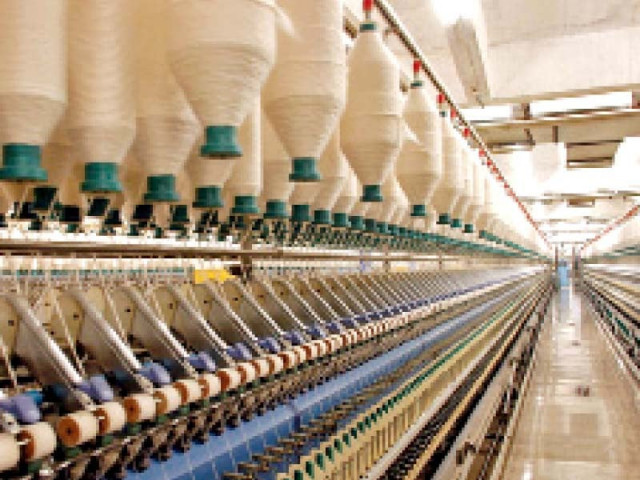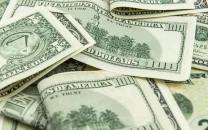Further subsidies of Rs100b demanded
Exporters want continuous supply of gas amid failure to honour past commitments

Powerful exporters are pressurising the government to cough up Rs100 billion more in subsidies through continued supplies of gas and incentives for exports of certain products amid their failure to honour past commitments.
The government, that is struggling hard to ensure gas supplies to the domestic and industrial consumers in the winters, is now faced with another challenge of dealing with the powerful exporters. On one hand, they are seeking uninterrupted supplies and on the other hand, they want cheap gas and additional incentives, which will cost additional Rs100 billion.
Sources told The Express Tribune that due to increasing prices of LNG, the cost of gas subsidies to exporters for the government will increase by another Rs35 billion, if it keeps supplying gas at the rate of $6.5 per mmbtu.
It has a choice either to increase the price or cut the supplies, because under the International Monetary Fund deal, the subsidies have to be fully covered in the budget. In addition to that, the exporters are demanding continuation of the Drawback on Local Taxes and Levies (DLTL) facility that will place an additional burden of around Rs65 billion on the exchequer.
The demand comes amid shrinking fiscal space that forced the government on Thursday to further reduce electricity subsidies for domestic consumers, resulting into 95 paisa per unit surge in tariff. The All Pakistan Textile Mills Association (Aptma) members are enjoying multiple subsidies. These include Duty and Tax Remission for Exports (DTRE), DLTL and Temporary Economic Refinance Facility (TERF) scheme by the State Bank of Pakistan and subsidised power and gas as well as tax exemptions.
Yet its performance remained dismal and the country’s total exports remained stagnant at around $25.6 billion in the last fiscal year -a level that was only 3% higher than the exports in the last year of the Pakistan Muslim League-Nawaz (PML-N) government.
There needs to be a cost-benefit analysis to reveal the hundreds of billions paid out to this sector in the form of subsidies since many years versus net increase in exports, according to a senior government functionary. The subsidies in their current form have led to rent-seeking and misuse in the textile sector. They are untargeted towards exporters and financially unsustainable, he added.
In the budget, the government had booked Rs26 billion gas subsidy, which is now estimated to increase to Rs62 billion annually. Power subsidy costs another Rs20 billion per annum. It is also unfunded, meaning that it adds to circular debt. The government had proposed to revise the existing gas tariff of $6.5 per mmbtu for the captive power plants of export sectors to $9 per mmbtu from November 15, 2021 to March 31, 2022. However, a member of the Aptma took a stay order form the court against the decision despite the fact that the lobby group had agreed to the increased prices due to higher LNG rates.
The exporters had also not met their other commitments in the past. They had got stay orders against heat rate tests and payments of Gas Infrastructure Development Cess. Energy Minister Hammad Azhar tweeted on Thursday that uninterrupted process gas was being supplied to the textile sector. Only the gas that is being used for captive power plants has been curtailed. The Aptma had also taken a court stay on its tariff increase due to rise in LNG prices to 9 cents per mmbtu from 6.5 cents.
The Aptma members are utilising expensive imported gas at cheaper rates and using 80% of it to generate their own electricity through captive power plants. Industrial units in Pakistan are allowed to install their captive power plants to produce electricity for their own use. And if they have surplus, they can supply it to the national grid for residential or commercial consumers.
There are 1,211 captive power units on both Sui Northern Gas Pipelines and Sui Southern Gas Company’s network, consuming about 415 mmcfd of gas. Out of this, 610 are export-oriented units and 601 are non-export oriented units, S&P Global reported in January this year. The captive units have efficiency of 30-38%, much lower than efficient power plants having efficiency of 50-62%, according to the publication.
Instead of giving untargeted subsidies, there is a need to link the subsidies with actual export proceeds, according to former special assistant to PM on energy Tabish Gohar.
A significant proportion of textile products is now supplied to local markets. The subsidy is also used to run inefficient captive power plants in the textile sector. On one hand, the government is sitting on surplus power while on the other hand, it ends up supplying precious and subsidised imported gas to run captive power plants.
The Aptma had agreed with the government in February last year to end the subsidy by June 2020 for gas in return for waiver of all additional charges on its bills. The government held its part of the bargain but the industry got the subsidy extended for another year on pretext of Covid-19, according to a cabinet minister. The government is offering electricity at 9 cents to exporters, which is even lower than domestic consumers’ rates and also relatively regionally competitive rate with Bangladesh having 8.5-cent rate.
Disallowance of gas to captive power plants will automatically shift the units towards power thereby boosting the much needed power uptake in a surplus system. But the powerful Aptma is resisting to give up the undue benefit.
Published in The Express Tribune, December 18th, 2021.
Like Business on Facebook, follow @TribuneBiz on Twitter to stay informed and join in the conversation.




1735506669-0/image-(16)1735506669-0-208x130.webp)














COMMENTS
Comments are moderated and generally will be posted if they are on-topic and not abusive.
For more information, please see our Comments FAQ